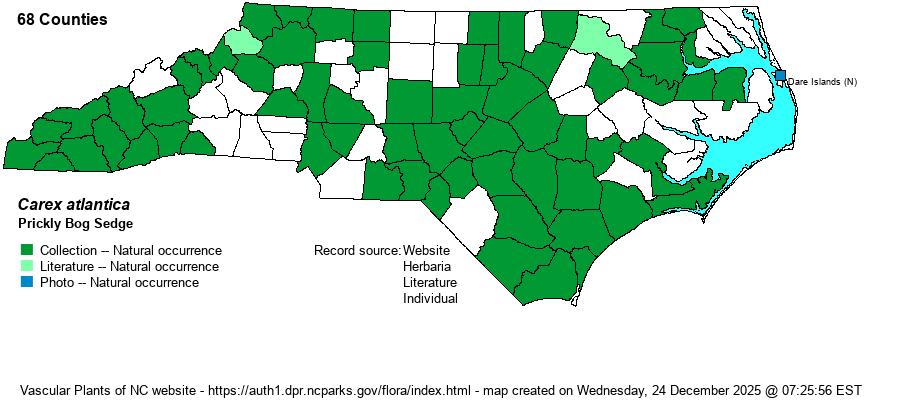| Section 5 » Order Cyperales » Family Cyperaceae |
Show/Hide Synonym
| taxonName | relationship | relatedTaxonName | relatedTaxonRefText | relComments |
|---|
|
|
| Carex atlantica | = | Carex atlantica var. atlantica | Gleason and Cronquist (1991) | | | Carex atlantica | > | Carex atlantica | Fernald (1950) | | | Carex atlantica | > | Carex atlantica | Gleason (1952) | | | Carex atlantica | > | Carex atlantica | Frye & Lea (2001). Key to sections adapted closely from FNA. | | | Carex atlantica | > | Carex atlantica | Radford, Ahles, and Bell (1968) | | | Carex atlantica | > | Carex atlantica | Small (1933, 1938) | | | Carex atlantica | > | Carex atlantica | Wofford (1989) | | | Carex atlantica | > | Carex incomperta | Fernald (1950) | | | Carex atlantica | > | Carex incomperta | Gleason (1952) | | | Carex atlantica | > | Carex incomperta | Frye & Lea (2001). Key to sections adapted closely from FNA. | | | Carex atlantica | > | Carex incomperta | Radford, Ahles, and Bell (1968) | | | Carex atlantica | > | Carex incomperta | Small (1933, 1938) | | | Carex atlantica | > | Carex incomperta | Wofford (1989) | | | Carex atlantica | = | Carex atlantica ssp. atlantica | Flora of North America (1993b, 1997, 2000, 2002a, 2002b, 2003a, 2004b, 2005, 2006a, 2006b, 2006c, 2007a, 2009, 2010) | | | Carex atlantica | = | Carex atlantica ssp. atlantica | Kartesz (1999) | | | Carex atlantica | = | Carex atlantica ssp. atlantica | | | | Carex atlantica | = | Carex atlantica ssp. atlantica | | | | Carex atlantica | = | Carex atlantica ssp. atlantica | Wunderlin & Hansen Flora of Florida (3) | | | Source: Weakley's Flora |
|
| Author | L.H. Bailey | |
| Distribution | Throughout the state, but rare on the Outer Banks. Current gaps will likely be filled in with additional collecting.
Nova Scotia to MI, IL, and MO south to northern FL and eastern TX. | |
| Abundance | Frequent to common, though scarce near the northeastern coast. Often common where found, the cespitose plants and multiple stems being conspicuous. The NCNHP's State Rank of S3 is woefully conservative; considering that there are collections from at least 66 counties, it is clearly an S5 species. | |
| Habitat | Seepage bogs, maple-gum swamps, cypress-gum swamps, streamhead pocosins --typically in acidic soils. |
| Phenology | Flowering and fruiting May-June. | |
| Identification | Closest to C. howei, and by some authors C. howei is treated as C. atlantica ssp. capillaris. Carex atlantica is separated by its coarser stems and broader leaves (1.6-4.5 mm wide vs. 0.8-1.6 mm) and longer perigynia (2.3-3.8 mm vs. 1.9-3 mm). | |
| Taxonomic Comments | Includes Carex incomperta. Note that C. atlantica ssp. capillacea has been elevated to full species status as C. howei.
The genus Carex is the largest in North America, and among the largest in the world. In temperate and boreal regions, Carex is often the dominant or co-dominant ground layer in many habitats. Seeds (achenes) are valuable food for birds and small mammals, while foliage is used by birds and mammals to make nests and as food by mammals. Species of Carex often look vastly different from one another -- spikes erect vs. drooping, tiny inflorescence vs. whopping, culms leafy vs. naked, perigynia beaked vs. beakless, stems densely bunched vs. single, etc. The genus has been divided into many sections (or groups), based on shared characters; some taxonomists have suggested that these be different genera, but that proves unworkable (so far). All Carex share the feature of a perigynium (an outer covering) which completely surrounds the achene (seed). This covering may fit tightly or loosely (like a small bladder), depending on which group or species. Details of perigynia shape, ornamentation, presence and size of beak, number of striations (or veins) are all important ID features. In recent years Rob Naczi and colleagues have stressed the importance of arrangement of perigynia -- whether spiral (3+ ranks) or distichous (2-ranked) -- and have named a number of new species as well as split off some older synonyms. Therefore, RAB's (1968) key, excellent for its time, can only be used in a general way today. Members of some sections of Carex are difficult to key out (notably Ovales, Laxiflorae, Griseae); this is in part due to variation among individuals of a species, or failings of the key. FNA has drawings of most species and some species may be found in two or more places within a key, to acount for variability. New species to NC, and new to science(!), continue to be found in NC. | |
| Other Common Name(s) | None | |
| State Rank | S3 [S5] | |
| Global Rank | G5 | |
| State Status | | |
| US Status | | |
| USACE-agcp | FACW link |
| USACE-emp | FACW link |

